如何上好第一堂英语课
- 格式:ppt
- 大小:169.00 KB
- 文档页数:34
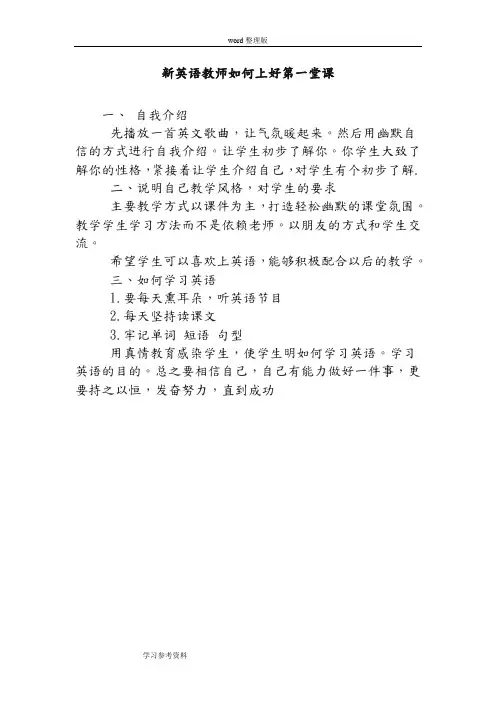
word整理版
新英语教师如何上好第一堂课
一、自我介绍
先播放一首英文歌曲,让气氛暖起来。
然后用幽默自信的方式进行自我介绍。
让学生初步了解你。
你学生大致了解你的性格,紧接着让学生介绍自己,对学生有个初步了解.
二、说明自己教学风格,对学生的要求
主要教学方式以课件为主,打造轻松幽默的课堂氛围。
教学学生学习方法而不是依赖老师。
以朋友的方式和学生交流。
希望学生可以喜欢上英语,能够积极配合以后的教学。
三、如何学习英语
1.要每天熏耳朵,听英语节目
2.每天坚持读课文
3.牢记单词短语句型
用真情教育感染学生,使学生明如何学习英语。
学习英语的目的。
总之要相信自己,自己有能力做好一件事,更要持之以恒,发奋努力,直到成功
学习参考资料。
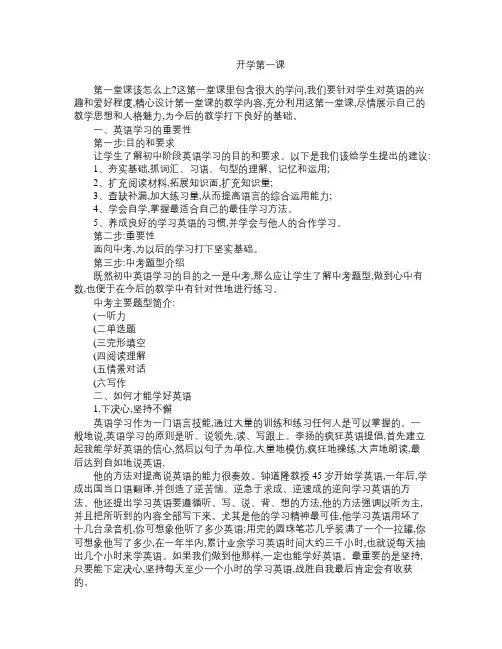
开学第一课第一堂课该怎么上?这第一堂课里包含很大的学问,我们要针对学生对英语的兴趣和爱好程度,精心设计第一堂课的教学内容,充分利用这第一堂课,尽情展示自己的教学思想和人格魅力,为今后的教学打下良好的基础。
一、英语学习的重要性第一步:目的和要求让学生了解初中阶段英语学习的目的和要求。
以下是我们该给学生提出的建议:1、夯实基础,抓词汇、习语、句型的理解、记忆和运用;2、扩充阅读材料,拓展知识面,扩充知识量;3、查缺补漏,加大练习量,从而提高语言的综合运用能力;4、学会自学,掌握最适合自己的最佳学习方法。
5、养成良好的学习英语的习惯,并学会与他人的合作学习。
第二步:重要性面向中考,为以后的学习打下坚实基础。
第三步:中考题型介绍既然初中英语学习的目的之一是中考,那么应让学生了解中考题型,做到心中有数,也便于在今后的教学中有针对性地进行练习。
中考主要题型简介:(一听力(二单选题(三完形填空(四阅读理解(五情景对话(六写作二、如何才能学好英语1,下决心,坚持不懈英语学习作为一门语言技能,通过大量的训练和练习任何人是可以掌握的。
一般地说,英语学习的原则是听、说领先,读、写跟上。
李扬的疯狂英语提倡,首先建立起我能学好英语的信心,然后以句子为单位,大量地模仿,疯狂地操练,大声地朗读,最后达到自如地说英语,他的方法对提高说英语的能力很奏效。
钟道隆教授45岁开始学英语,一年后,学成出国当口语翻译,并创造了逆苦恼、逆急于求成、逆速成的逆向学习英语的方法。
他还提出学习英语要遵循听、写、说、背、想的方法,他的方法强调以听为主,并且把所听到的内容全部写下来。
尤其是他的学习精神最可佳,他学习英语用坏了十几台录音机,你可想象他听了多少英语;用完的圆珠笔芯几乎装满了一个一拉罐,你可想象他写了多少,在一年半内,累计业余学习英语时间大约三千小时,也就说每天抽出几个小时来学英语。
如果我们做到他那样,一定也能学好英语。
最重要的是坚持,只要能下定决心,坚持每天至少一个小时的学习英语,战胜自我最后肯定会有收获的。

初中英语教案之第一课:练习听力和口语表达能力英语学习的第一步就是听说,而听力和口语表达能力一直都是英语学习的难点。
因此,初中英语教案之第一课就是要让学生熟练掌握听力和口语表达能力。
如何帮助学生提高听力和口语表达能力呢?下面是初中英语教案之第一课的几个部分。
第一部分:听力训练听力训练是初中英语教学中最重要的一部分,因为语言这种学科,听力练得好,其他的就容易跟上。
在听力训练方面,我们可以从以下几个方面着手。
1.培养学生的听力兴趣听力是需要长期培养的,因此,最先要考虑的就是如何让学生对听力产生兴趣。
我们可以通过多媒体教学、生动有趣的听力材料、实用的听力练习等方式,激发学生的听力兴趣。
2.营造良好的听力环境听力是需要良好的环境的,学生在听力训练的时候,需要好的音响设备、清晰的录制材料等。
同时,教室的环境也需要安静、整洁,以营造出良好的听力环境。
3.分层次进行听力训练不同的学生听力水平不同,因此,我们需要根据学生的实际情况,分层次进行听力训练。
对于初中一年级学生,可以从简单的听力材料开始,让学生逐渐适应英语的语音和语调,然后再逐渐提高难度,以达到提高学生听力水平的目的。
第二部分:口语表达训练除了听力训练之外,口语表达训练也是非常重要的。
在初中英语教学中,我们可以采用以下几种方式来帮助学生提高口语表达能力。
1.与学生进行对话在教学中,教师可以与学生进行对话,让学生在语言交流中逐渐提高口语表达能力。
同时,对话的话题也需要与学生的实际情况相符,以便学生更好地理解和掌握语言。
2.创设情境在学习过程中,教师可以创设一些情境和角色扮演,让学生在与教师或其他同学的交流中,锻炼口语表达能力。
3.培养学生的自信心很多学生在学习英语时,存在着害怕发音错误或语法错误的情况,这样会导致他们不敢开口说话。
因此,教师需要及时鼓励学生,让他们养成习惯多开口说话的习惯,并且在发音和语法上给予适当的指导和帮助,让学生在实践中逐渐提高口语表达能力。
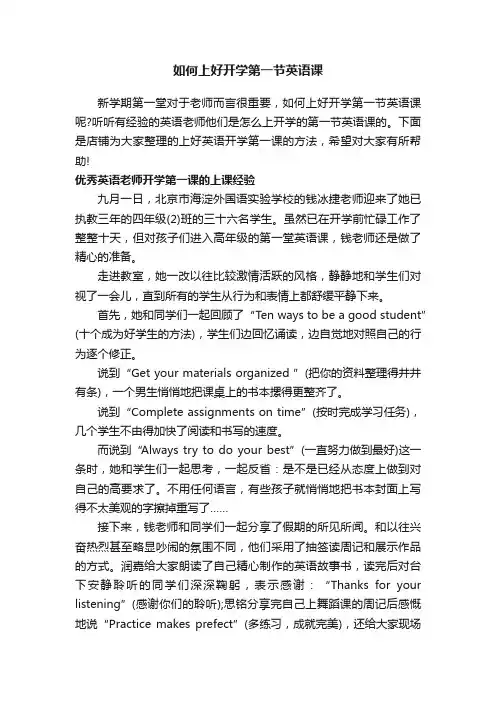
如何上好开学第一节英语课新学期第一堂对于老师而言很重要,如何上好开学第一节英语课呢?听听有经验的英语老师他们是怎么上开学的第一节英语课的。
下面是店铺为大家整理的上好英语开学第一课的方法,希望对大家有所帮助!优秀英语老师开学第一课的上课经验九月一日,北京市海淀外国语实验学校的钱冰捷老师迎来了她已执教三年的四年级(2)班的三十六名学生。
虽然已在开学前忙碌工作了整整十天,但对孩子们进入高年级的第一堂英语课,钱老师还是做了精心的准备。
走进教室,她一改以往比较激情活跃的风格,静静地和学生们对视了一会儿,直到所有的学生从行为和表情上都舒缓平静下来。
首先,她和同学们一起回顾了“Ten ways to be a good student” (十个成为好学生的方法),学生们边回忆诵读,边自觉地对照自己的行为逐个修正。
说到“Get your materials organized ”(把你的资料整理得井井有条),一个男生悄悄地把课桌上的书本摞得更整齐了。
说到“Complete assignments on time”(按时完成学习任务),几个学生不由得加快了阅读和书写的速度。
而说到“Always try to do your best”(一直努力做到最好)这一条时,她和学生们一起思考,一起反省:是不是已经从态度上做到对自己的高要求了。
不用任何语言,有些孩子就悄悄地把书本封面上写得不太美观的字擦掉重写了……接下来,钱老师和同学们一起分享了假期的所见所闻。
和以往兴奋热烈甚至略显吵闹的氛围不同,他们采用了抽签读周记和展示作品的方式。
润嘉给大家朗读了自己精心制作的英语故事书,读完后对台下安静聆听的同学们深深鞠躬,表示感谢:“Thanks for your listening”(感谢你们的聆听);思铭分享完自己上舞蹈课的周记后感慨地说“Practice makes prefect”(多练习,成就完美),还给大家现场跳了一段街舞的基础舞步,赢得了阵阵掌声。
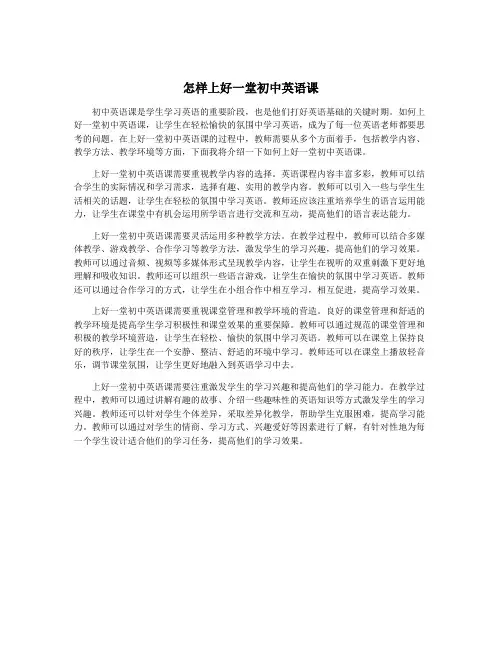
怎样上好一堂初中英语课初中英语课是学生学习英语的重要阶段,也是他们打好英语基础的关键时期。
如何上好一堂初中英语课,让学生在轻松愉快的氛围中学习英语,成为了每一位英语老师都要思考的问题。
在上好一堂初中英语课的过程中,教师需要从多个方面着手,包括教学内容、教学方法、教学环境等方面,下面我将介绍一下如何上好一堂初中英语课。
上好一堂初中英语课需要重视教学内容的选择。
英语课程内容丰富多彩,教师可以结合学生的实际情况和学习需求,选择有趣、实用的教学内容。
教师可以引入一些与学生生活相关的话题,让学生在轻松的氛围中学习英语。
教师还应该注重培养学生的语言运用能力,让学生在课堂中有机会运用所学语言进行交流和互动,提高他们的语言表达能力。
上好一堂初中英语课需要灵活运用多种教学方法。
在教学过程中,教师可以结合多媒体教学、游戏教学、合作学习等教学方法,激发学生的学习兴趣,提高他们的学习效果。
教师可以通过音频、视频等多媒体形式呈现教学内容,让学生在视听的双重刺激下更好地理解和吸收知识。
教师还可以组织一些语言游戏,让学生在愉快的氛围中学习英语。
教师还可以通过合作学习的方式,让学生在小组合作中相互学习,相互促进,提高学习效果。
上好一堂初中英语课需要重视课堂管理和教学环境的营造。
良好的课堂管理和舒适的教学环境是提高学生学习积极性和课堂效果的重要保障。
教师可以通过规范的课堂管理和积极的教学环境营造,让学生在轻松、愉快的氛围中学习英语。
教师可以在课堂上保持良好的秩序,让学生在一个安静、整洁、舒适的环境中学习。
教师还可以在课堂上播放轻音乐,调节课堂氛围,让学生更好地融入到英语学习中去。
上好一堂初中英语课需要注重激发学生的学习兴趣和提高他们的学习能力。
在教学过程中,教师可以通过讲解有趣的故事、介绍一些趣味性的英语知识等方式激发学生的学习兴趣。
教师还可以针对学生个体差异,采取差异化教学,帮助学生克服困难,提高学习能力。
教师可以通过对学生的情商、学习方式、兴趣爱好等因素进行了解,有针对性地为每一个学生设计适合他们的学习任务,提高他们的学习效果。
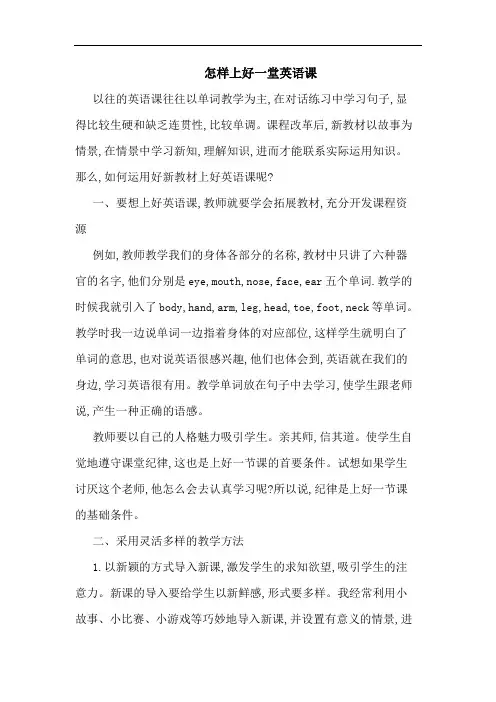
怎样上好一堂英语课以往的英语课往往以单词教学为主,在对话练习中学习句子,显得比较生硬和缺乏连贯性,比较单调。
课程改革后,新教材以故事为情景,在情景中学习新知,理解知识,进而才能联系实际运用知识。
那么,如何运用好新教材上好英语课呢?一、要想上好英语课,教师就要学会拓展教材,充分开发课程资源例如,教师教学我们的身体各部分的名称,教材中只讲了六种器官的名字,他们分别是eye,mouth,nose,face,ear五个单词.教学的时候我就引入了body,hand,arm,leg,head,toe,foot,neck等单词。
教学时我一边说单词一边指着身体的对应部位,这样学生就明白了单词的意思,也对说英语很感兴趣,他们也体会到,英语就在我们的身边,学习英语很有用。
教学单词放在句子中去学习,使学生跟老师说,产生一种正确的语感。
教师要以自己的人格魅力吸引学生。
亲其师,信其道。
使学生自觉地遵守课堂纪律,这也是上好一节课的首要条件。
试想如果学生讨厌这个老师,他怎么会去认真学习呢?所以说,纪律是上好一节课的基础条件。
二、采用灵活多样的教学方法1.以新颖的方式导入新课,激发学生的求知欲望,吸引学生的注意力。
新课的导入要给学生以新鲜感,形式要多样。
我经常利用小故事、小比赛、小游戏等巧妙地导入新课,并设置有意义的情景,进行启发式提问。
2.教学过程中每一个教学环节的时间分配要合理,教学环节之间过渡要自然。
在活动中,可视教学实际穿插进行个体活动、小组活动、全班活动,同时不要忘记给学生自学、独立思考的时间。
3.教学活动中要照顾成绩较差的学生。
在教学中,我经常设计一些“一帮一”活动,也就是让一个英语水平相对较高的学生和一个成绩较差的学生一起操练;在小组活动中,每个小组有各个层次的学生,小组之间实力相当,在活动中就很容易营造一种“你争我赶”的学习气氛。
4.“教学是一种艺术。
”在课堂上,我们应该在教学方法上多下一点功夫,使课堂教学新颖、有趣,正所谓“教无定法”,教法要常教常新。


英语:农村初中英语教师如何上好第一堂课大多数农村小学生升入初中时,对英语一无所知。
要使他们对你的英语学科感兴趣,上好第一堂课至关重要。
为此,教师必须作好充分准备,才能收到满意的效果。
我们可以这样设计首堂英语课:第一步:用英语问候学生,然后以流利的口语自我介绍,以激起学生对英语的好奇心。
好奇,就能激起兴趣,就能产生学习动力。
第二步:利用世界地图或地球仪介绍英语及世界上以英语为母语的国家,让学生在地图上一一指出。
让他们知道,世界上有多少个国家、有多少人每天都在用英语进行交流。
第三步:让学生明白,英语是世界上使用最为广泛的语言,在世界上有很高的国际地位。
中国成功地加入WTO、申奥成功等,都要求我们21世纪的中国青少年熟练掌握英语。
第四步:介绍学习英语的科学方法,并介绍词典、录音机及复读机对英语学习的促进作用,要求有条件的学生作好准备。
第五步:告诉学生,要学好英语就得学好语音、词汇、语法和口语。
其中,语音是学好后三者的必备基础;口语是学好英语的最高境界,学习英语的最终目的就是为了熟练地与人交流。
此时可介绍一些简单的常用口语,只要求学生听说,以激发兴趣。
第六步:告诉学生,现在有条件的小学从三年级、甚至一年级或幼儿园起就已开始学习英语,但我们农村中学的孩子没那个条件,直到上了初中才起步。
我们已经比城市孩子落后了不少,我们应该看到差距。
但更重要的是,我们要树立信心,奋起直追,力争赶上甚至超过他们!第七步:教唱字母歌,为第二堂英语课的字母教学打下基础。
第八步:用好“Goodbye!”、“Bye-bye!”、“Bye!”、“See you。
”等告别用语与学生道别。
这是笔者就上好农村初中第一堂英语课的一些构想。
当然,教无定法,但限于多数农村初中的现有条件,这堂课差不多就这模式。
有条件的学校完全可以充分利用自身优势,用好投影仪、CAI课件等先进的现代教学手段,使各自的首堂课生动精彩、富有吸引力,为本轮英语教学开一个好头。
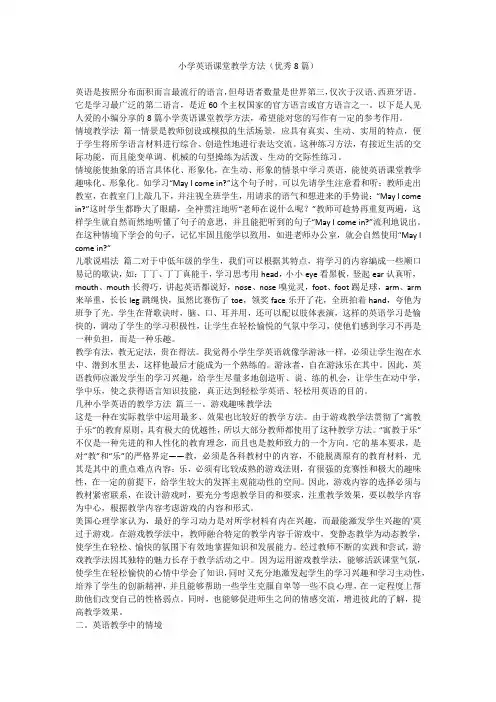
小学英语课堂教学方法(优秀8篇)英语是按照分布面积而言最流行的语言,但母语者数量是世界第三,仅次于汉语、西班牙语。
它是学习最广泛的第二语言,是近60个主权国家的官方语言或官方语言之一。
以下是人见人爱的小编分享的8篇小学英语课堂教学方法,希望能对您的写作有一定的参考作用。
情境教学法篇一情景是教师创设或模拟的生活场景,应具有真实、生动、实用的特点,便于学生将所学语言材料进行综合、创造性地进行表达交流。
这种练习方法,有接近生活的交际功能,而且能变单调、机械的句型操练为活泼、生动的交际性练习。
情境能使抽象的语言具体化、形象化,在生动、形象的情景中学习英语,能使英语课堂教学趣味化、形象化。
如学习“May I come in?”这个句子时,可以先请学生注意看和听:教师走出教室,在教室门上敲几下,并注视全班学生,用请求的语气和想进来的手势说:“May I come in?”这时学生都睁大了眼睛,全神贯注地听“老师在说什么呢?”教师可趁势再重复两遍,这样学生就自然而然地听懂了句子的意思,并且能把听到的句子“May I come in?”流利地说出。
在这种情境下学会的句子,记忆牢固且能学以致用,如进老师办公室,就会自然使用“May I come in?”儿歌说唱法篇二对于中低年级的学生,我们可以根据其特点,将学习的内容编成一些顺口易记的歌诀,如:丁丁、丁丁真能干,学习思考用head,小小eye看黑板,竖起ear认真听,mouth、mouth长得巧,讲起英语都说好,nose、nose嗅觉灵,foot、foot踢足球,arm、arm 来举重,长长leg跳绳快,虽然比赛伤了toe,领奖face乐开了花,全班拍着hand,夸他为班争了光。
学生在背歌诀时,脑、口、耳并用,还可以配以肢体表演,这样的英语学习是愉快的,调动了学生的学习积极性,让学生在轻松愉悦的气氛中学习,使他们感到学习不再是一种负担,而是一种乐趣。
教学有法,教无定法,贵在得法。
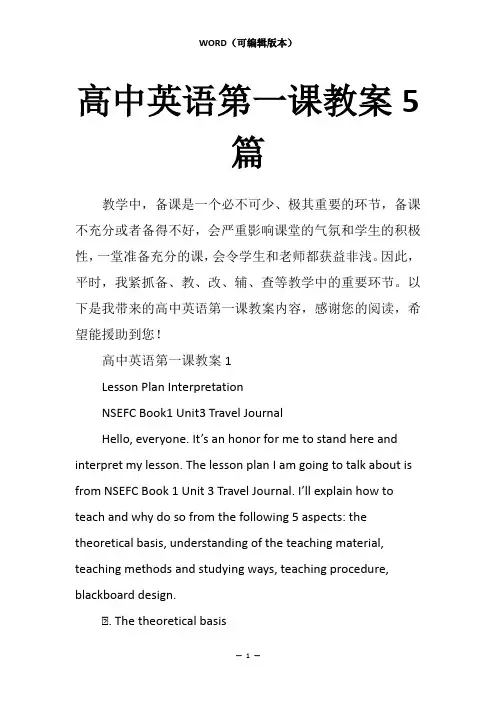
高中英语第一课教案5篇教学中,备课是一个必不可少、极其重要的环节,备课不充分或者备得不好,会严重影响课堂的气氛和学生的积极性,一堂准备充分的课,会令学生和老师都获益非浅。
因此,平时,我紧抓备、教、改、辅、查等教学中的重要环节。
以下是我带来的高中英语第一课教案内容,感谢您的阅读,希望能援助到您!高中英语第一课教案1Lesson Plan InterpretationNSEFC Book1 Unit3 Travel JournalHello, everyone. It’s an honor for me to stand here and interpret my lesson. The lesson plan I am going to talk about is from NSEFC Book 1 Unit 3 Travel Journal. I’ll explain how to teach and why do so from the following 5 aspects: the theoretical basis, understanding of the teaching material, teaching methods and studying ways, teaching procedure, blackboard design.Ⅰ. The theoretical basisFirst, I’d like to show my theoretical basis--schema theory and top-down model (Goodman, 1971). Journey down the Mekong is a reading course. According to schema theory, reading prehension is an interactive process between the reader’s background knowledge and the text (Carrel and Eisterhold, 1983), or between the new information and the old knowledge store (Anderson and Pearson, 1984). So in order to improve the students’ reading speed and reading prehension, language teachers should try to activate the Ss’ old knowledge store and add more relevant background knowledge before they get the students to read. According to the top-down model, general idea of the text will be got first, and then e the details.II. Understanding of the teaching materialMy understanding of the teaching material includes 3 parts: the status and the function, teaching objectives, the important and difficult points.At the beginning, let’s focus on the first part. Journey down the Mekong is a piece of travel journal written by Wang Kun. It’s mainly about Wang Kun and his sister’s dream of taking a great bike trip down the Mekong River, their preparation for the trip and some more details of the Mekong River. General speaking, it is not difficult for the students to understand thetext, but there are some new phrases and sentences that may be a little bit difficult. So before the students’ first reading, I will explain the new words and phrases briefly and after reading the whole passage, I will embody the usage of the news words and phrases, and get the student understand the difficult sentences. As it is a piece of journal, besides learning the new words and phrases, students can get the general idea of how to write a journal.That’s all for the first part, now let’s move to the second part. According to the teaching material and the new curriculum of English, in order to fulfill the learning task of this lesson, I establish the following objectives:a) Knowledge objectivesBy the end of the lesson, Ss will have a better understanding of the meaning and structure of the text. Then Ss will grasp some useful words and expressions such as determined, make up one’s mind, give in, be fond of …, care about…, stubborn, etc.b) Ability objectivesActually students should be encouraged to do speed reading in the first period of reading lesson. But the students in my class are lack of independent reading ability. In this class, Iwill encourage and help them to read, think and find out information by themselves most time. Since the main objective of reading course is to improve the Ss’ reading ability, I’ll train their ability of identifying the general idea in the fast reading. And in intensive reading their ability of information-gathering and summarizing is developed. And the whole class is for Ss to develop their reading skills as scanning, skimming, information-gathering, summarizing and guessing the new words from the text.c) Moral objectivesThough Journey down the Mekong is mainly about the trip down the river, it also talks about the scenery and life along the river. So before learning the text, we will have a short discussion about the importance of the river. I want the Ss to have the awareness of protecting the river and protecting our environment.Well, so much for the teaching objectives, lets e to deal with the third part: the important points and the difficult points. According to the national curriculum of English and language learning theory, when teaching reading, we should encourage the Ss to do speed reading for the first time, that’s to say, we should encourage our Ss to read as fast as they can when theydo the first reading. So much emphasis should be put on reading skills and reading prehension as well. So the important points are that how to make Ss grasp the new words and phrases and how to improve their reading skills as scanning, skimming, information-gathering and summarizing. As to the difficult points, they are the same as the important ones.III. Teaching methods and studying waysThat’s all for my understanding of the teaching material. Now let’s focus on the ways of teaching and learning.Generally speaking, I adopt task-based language teaching and municative approach in my class. As for learning, Ss will learn through independent reading, discussing and cooperating.I will use puter and blackboard as my teaching aids.Ⅰ. Teaching procedureHere es the most important part, the teaching procedure. It includes 5 steps: Step I: Lead-in andpre-reading, Step II: While-reading, Step III: Consolidation, Step IV: Post-reading, Step V: Homework.Step I: Lead-in and pre-reading (7mins)Now let’s e to the first step. There are three activities in this step and I will spend 7mins on them.In activity one, I will ask Ss two questions Do you know some great rivers in China? and Why they are great?” Here, asthe Ss get familiar with the Chinese great rivers, I choose to ask them some great rivers in China. And the answer to the second question can lead in the next activity--brainstorming.In activity two, I will ask the Ss to discuss in pairs and answer the question How do people who live along a river use it?” My purpose of this activity is to remind the Ss the importance of the river, thus stimulate the Ss awareness of protecting the rivers.In the last activity, I will show the Ss a picture of the Mekong River and ask them to list the countries that it flows through. This activity leads in the while-reading.Step II: While-reading (21mins)While-reading is the main part and it will take 21mins. Here I adopt the top-down reading model. This step is divided into 2 parts: fast reading and careful reading. Before reading, I will ask the Ss to predict what will talk in the text according to the title. It can exert the Ss imagination.1) Fast readingDuring fast reading, I will ask the Ss to reading the whole passage quickly and get the main idea of each paragraph. Usually, the main idea of each paragraph is the first sentence or the last sentence, but this text is not. So the main idea of eachparagraph will be matched because the Ss are lack of the skill of summarizing the main idea by themselves.2) Careful readingAfter getting the general idea of each Para., I will deal with the details Para. by Para..In paragraph one, I will ask the Ss to read quickly and do the exercises T or F. And if it is F, I will ask them to correct it. This exercise can help the Ss get the key information of the first paragraph in a short time and can deepen the Ss’ understanding of the first paragraph.In paragraph two, I will ask Ss one question “Is it a difficult journey to cycle along the Mekong? Why?” This can help the Ss develop their ability of summarizing. If the Ss can’t answer the question briefly, I will encourage them to find the key sentences and try to join them together.And in the last paragraph, I will ask Ss two questions “How does the water of Mekong River change?” and “What can you see when you travel along the Mekong River?” Both questions are required to answer in keys word. In order to lower the difficulty of the questions, I will show them the examples. After that, I will present some pictures to deepen the Ss’ impression on the new words. And these two questions can help the Ssgain a deeper understanding on the Mekong River.Step III: Consolidation (6mins)After dealing with the detailed information of each paragraph, I will ask the Ss to read the whole passage again and answer two questions to consolidate what they’ve learnt. It will take 6 minutes. The two questions are “Where is the source of the Mekong River and which sea does it enter?” and “How do Wang Kun and Wang Wei prepare for the trip?” It is easy for the Ss to find the answer to the first question in the text. As to the second question, it may be a little difficult, so I will list some tips for the Ss to find the answer more easily.Step IV: Post-reading (10mins)That’s all for the while-reading. Now let’s move to the fourth step. In this step, I will design two activities and I will spend 10 minutes on them.The first activity is filling in the blanks. In this activity, Ss are required to find the different attitudes of Wang Kun and Wang Wei to the trip, and then the teacher will express her attitude to this trip. After demonstrating, Ss are encouraged to express their attitudes. It can help the Ss train their ability of information-gathering and expression.The second activity is thinking. In this activity, I will ask theSs to discuss in groups of four and try to use some words to describe the characteristics of Wang Kun and Wang Wei according to their attitudes. It is really difficult, but it can not only train their ability of analysis and prehension, but also cultivate their spirit of cooperationStep V: Homework (1min)Finally it es to the homework. Ss are required to review the learnt lesson and underline the useful words and phrases in the text. This one is for them to consolidate what they’ve learnt and make preparation for the next lesson—Learning about the Language..Ⅰ. Blackboard designOn the top, there is the title of this lesson. On the left, it lists some important roles that the river plays. On the right, there are some useful words and expressions.That’s all for my interpretation. Thank you for your att高中英语第一课教案2一. 教材内容分析本单元的中心话题是“电影”,本课是第三课时,是一篇传记体的短文,介绍当前好莱坞最有影响的导演艺术家—史蒂芬斯皮尔伯格的创作生涯和一些作品。
![[转载]如何上好第一节英语课](https://uimg.taocdn.com/b49e26387e21af45b207a82c.webp)
[转载]如何上好第一节英语课大中小订阅如何上好三年级英语第一课对于在课堂上第一次正式接触英语的农村学生来说,英语就是黄头发、蓝眼睛、白皮肤外国人的语言,在电视或电影里偶有听见,也是只听其声,不会其意.在这种情况下,如何上好孩子们人生中第一堂英语课,是至关重要的.我们都知道良好的开端是成功的一半,而且兴趣是最好的老师,因此如何上好孩子们这堂课是每一位英语老师该认真思索和探讨的问题.我个人认为应该从以下几点内容着手:一、课前精心准备―英语名片小学生好奇心、模仿性都很强,利用这个特点,在第一节课就开始激发学生对英语学习的浓厚兴趣.那么在课前该做哪些准备呢?首先,我觉得作为一个老师,形象也是非常重要的,尤其是英语老师.因为在学生的心目中,英语老师是个会说外国话的老师,和其他老师还是有点区别的.因此,男教师可以绅士一点,女教师可以更加洋气一点.如果学生在第一印象就喜欢上你这个老师的话,那么在以后的学习中,学生也会爱屋及乌,爱上英语这门学科.这是因为孩子的“喜恶”是非常分明的,喜欢的他们就全力去做,不喜欢的就提不起兴趣.第二,给孩子们准备一份小礼物――自制的英文名片,既能拉近我们老师与孩子们之间的距离,让学生了解老师,反之,学生也更乐于亲近老师,那这节课的情感交流就基本达标了,不仅如此,发放带着英文的名片又能让学生真切的体会英语,用英语来做事,课后还能让学生也试着动手设计制作一张名片,送给老师,让老师更快更好地了解学生.二、课堂交流――英语开场白既然是英语课,就应该有一个“带有英语”的开场白.走进教室后,我一边招手一边面带笑容的用英语和学生说“hello!boysandgirls!”,并简单介绍“i’myournewenglishteacher.yo ucancallmemissyan"然后互相用”hello!"打招呼,这个时候学生还有些胆怯,不能完全放开,我就竖起大拇指略微夸张的表扬他们:"verygood!"“hownice!"进一步打消他们对英语的畏惧感,并且让学生在第一时间领略到英语的风采.虽然很多英语学生不能听懂,但是学生越是听不懂,就越想知道是什么意思,这样就越能激发学生对英语的好奇和兴趣.当然,需要注意的是,教师也不能只顾着展示“风采”,不管学生是否明白,这样,时间一长,学生就会觉得疲劳、索然无味.因此,教师在说的同时要配以相应的体态语言,帮助学生理解意思.总而言之,第一节英语课必须用英语作为开场白,激发学生学习的欲望.三、让学生了解生活中的英语英语其实离我们学生的日常生活一点都不远,在他们的学习用品上、书包上、文具盒上、故事书上等等,很多地方都能找到英语;外出就餐,很多食物名称其实就是英语直译过来的,如coffee,hamburger等;还有很受孩子们欢迎的牙膏品牌――纳爱斯,其实就是nice的音译,表示美好,整洁;而一些感叹词,如:yeah!wow!cool!等更是广泛出现在孩子们的口中.这样一一介绍之后,孩子们突然豁然开朗,发现其实英语也不是很神秘很遥远的,无意识中我们已经在运用英语了.四、要让学生有学好英语的信念如果说以上三点是为了激发学生对英语学习的兴趣,那么除此之外,我觉得还应该引导和培养学生有一个坚强的意志.首先,让学生明白,我们现在是站在同一起跑线上的,我们是同时开始学习英语的,谁勤奋了,谁努力了,那么谁就是冠军,谁懒惰,谁不思进取,那么谁就落后.如果大家都想成为冠军也是未尝不可的,只要大家都有一个好的学习英语的习惯,那么大家就可以并肩齐进.因此第二,就是要和学生一起订立一个学习英语的制度.比如,坚持每天听英语磁带10~15分钟,每天大声朗读课文,每一页内容都要在规定时间内到老师处过关,同学之间尽量用学过的英语进行对话等.同时要强调一定要坚持下去,不要过了几天就把学英语的事忘了,没有恒心.总之,在上第一堂课之时,教师就要让学生建立起对英语课的初步印象,激发起对英语学习的兴趣、引导学生正确的学习动机、培养他们不畏艰难的学习意志,以保证他们日后的英语学习一路顺风.如何上好新高一生的第一节英语课(教学案例)我们知道,上好一节课的先决条件是教师要有扎实的基本功,同时还须要用心的备好课,既要备教材,备教法学法,还需备学生及偶发事件等,另外还要注意上课的一些技巧,才能为自己的课堂锦上添花.根据以上的教学法指导思想,我在面对新高一生上第一节英语课时采用了“首节课五步法”教学.作为一名英语教师,结合以往的教学经验,我在课前做了精心的准备,如整洁的穿戴,得体的衣着会给学生的第一视觉留下美好的印象,让学生产生一种亲和,敬佩和友善的感觉,为今后教学工作的顺利开展设下伏笔,使整堂课的教学过程严谨而有序,收到了理想的教学效果.首先,初步的介绍.(firstintroduction)(3-5分钟)初步的介绍的内容包括欢迎大家进入高一,自我介绍,高一英语课程的特点和变化等.初步介绍的形式应该尽量简洁明了,言简意赅,幽默风趣而又不失儒雅风范.如自我介绍中简略的介绍自己的从教经历(学生对此很感兴趣)毕业院校,家乡和你希望学生对你的称呼(你的姓氏、英文名,以便日后课前的问候)通过这样初步的介绍让学生认识了你,拉近了你和学生的距离.第二步,自由谈.(freetalk)(大约15分钟)趁热打铁,刚刚学生认识了你,也是一个很好的示范,我们课堂要讲究互动,这一步让学生也谈谈他们自己,主要围绕以下几方面让学生张口,感受一下英语的魅力,表达自我,可就学生刚刚暑假结束让他们在自我介绍后,谈谈他们的暑假生活,他们的兴趣爱好,朋友家人,未来计划(上高一的打算)等等,这一步不必限定内容,让学生有话可说,让学生上讲台自由表达,每人可进行2―3分钟的小演讲.从这一步也可以观察出班级里面一些英语学习的活跃分子和一些擅长表达的学生,如果需要挑选课代表和英语学习小组长这也是个很好的发现的手段,课前准备好他们的座位表做好记录.实践证明,这一步若引导的好,让他们有话敢说,可以很好的活跃课堂气氛,为进入下一环节做好铺垫.第三步,提出新要求、新希望.(presentnewrequirement&hope)(3-5分钟)就“新”字做文章,学生虽经过初中的学习,对高中生活尚不了解,可能多少有些新鲜感可言,这时可就他们刚刚组成的新班级,新学年遇到的新的英语老师从而提出新的要求与希望,关键是要新,那些常规要求经过初中的洗礼他们都知道了,不必老调重弹,所以要创新.我就给他们提出一个字的要求与希望:cooperation(合作),并且让他们跟我学习了这个词的拼读和习惯用法,让他们明白该要求的内涵和外延.在以后的教学中,也发现证明这点要求的魅力无穷,可以很好的诠释.希望学生能愉快地合作一年,学生也一致同意,如此让学生喜欢上你,进而喜欢上这门英语课,所谓“亲其师、信其道”.第四步,简略介绍高一英语的基本学习方法,并送上几条英语谚语.(adviceaboutlearningenglishandsomeenglishproverbs)(15分钟左右)要想学好英语,特别是高一英语,必须有端正的学习态度.态度决定一切,细节决定成败(attitudeiseverything).还要有科学的学习方法.“在科学上没有平坦的大道,只有不畏劳苦沿着陡峭山路攀登的人,才有希望达到光辉的顶点.”(马克思)(thereisnoshortcutinthescienceroad,onlybedeligent.)学英语要做到“勤”字当头,勤用心、勤记、勤练、勤问、勤归纳比较.勤学好问,特别是要善于发现问题、提出问题,并通过问同学、问老师等来解决问题,从而逐步提高自己的英语水平.勤工出巧匠(workmakestheworkman).认真听讲,做好课堂笔记,做到多管齐下,五官并用,即眼看、耳听、脑想、口说、手写,从而提高课堂效率.良好的开端是成功的一半,从现在开始(agoodbeginningishalfdone).积极大胆,对于我们来说,英语是一门外语,初学时出错或读不准是自然现象.因此,我们要打消畏惧心理,积极大胆地去练习,不怕出错、不怕读不准,甚至不怕别人笑话.不要害怕,只要一试(don’tbeshy,justtry.).学好英语不是轻而易举就能达到的,学好它的确是一件苦差事,我们应该做好吃苦的准备,苦中求乐,苦练多用,勤练习多用,方可熟能生巧(practicemakesperfect).持之以恒.要想学好英语,单靠一时的激情和冲动、只图一时新鲜是不行的(alittleknowledgeisadangerousthing).它是一项长期工程.只有坚持,才会学有所成(youneverknowwhatyoucantillyoutry).否则,只能半途而废.至于单词、语法,四项技能的培养的具体方法,我在给学生的“致英语学习者――征服英语的33条军规(中英对照)”都有详细的论述,印成讲义发给学生课后学习.最后,布置作业.(homework)(2-3分钟)1.用英语写一篇短文简要介绍自己和对高一学习的打算.(title:self-introductionandsenioriilearningplan).2.熟读学习“致英语学习者――征服英语的33条军规”.3.准备好“三本”――作业本(3个),课本(必备),笔记本(自备).4.预习新单元课程内容.总之,以上介绍的“首节课五步法”教学设计和思考是笔者根据近两年的教学实践摸索与总结的成果,经过实践检验与证明,这一方法得到了历届所带班级学生的认可与欢迎.在所带的学生中有很多在日后对我说我的第一节课给他们留下了深刻的印象,让他们重对英语燃起了希望,激发了他们的学习热情与信心,使他们看到了学好英语的曙光.第一节英语课厦门十中吴瑞芳作为一名初中英语教师,我已经带过两届学生,上过三次初一新生的第一节英语课,各有不同,感想颇多.第一次印象深刻,我带着一本教科书、一本英文的电视机使用说明书和一个生活中常见的英文标识(wc)上了讲台.通过给学生展示说明书和英文标识,告诉他们学习英语的重要性和必要性,接着,就开始介绍教科书的有关情况.学生的注意力大约只持续了5分钟在那些材料上,之后对我的讲述就有些心不在焉了.这第一节英语课就草草的了结了.第二次我吸取了教训,改变了策略和方法.这次,我先用英语进行自我介绍:mynameiswuruifang.i’myourenglishteacher.这些大多数学生能听得懂,因为他们小学时已学过.先用英语讲,可以让学生进入一种语言氛围,同时能尽早熟悉老师的口语,对接下来的学习打下基础.在这之后,我就用英语询问了一部分同学的情况,如:what’syourname?howoldareyou?doyoulikeenglish?等等.这样就花去了80%的时间,剩余的时间就对英语课的学习提了一些要求.这一次,学生的注意力有了较大的提高,因为他们对老师,同学的情况都有一种想要知晓的好奇,所以,当老师在自我介绍和提问同学时都汇集中精神去听.这样的效果比第一次有了明显提高.可我觉得,让学生参与的面还不够广,学生表达的机会还不够多,还应有所改进.第三次,也就是最近的这一次,英语也加入了课程改革的范围,新的课改理念、教学方式和评价体系,都要求老师从面向全体学生,发展学生的全面素质的角度出发,发挥学生学习主体作用,老师应起到良好的主导性.根据这一指导思想并结合前两次的经验,我设计了这第三次的第一节英语课.这是我的开场白:hello,everyone.howdoyoudo?i’myourenglishteacher.mynamei swuruifang.couldyouintroduceyourselftome?nicetomeetyou.在我说到howdoyoudo?和nicetomeetyou.时,绝大多数学生立刻回答howdoyoudo?和nicetomeetyou,too.这说明他们不仅在认真听讲而且听得懂.对于学生较难理解的introduceyourselftome我做了适当的汉语解释.很快,就有一个大胆的女生站起来自我介绍.她的英语口语既清楚又流利,表达完全正确,让我和全班同学都大吃一惊,我大声地称赞她excellence!并带领全班同学给她鼓掌.她就是后来该班的班长兼我的英语课代表―朱颖同学.在这种氛围的感染下,全班50个学生有47个能主动站起来进行简短的自我介绍,另外3个同学在我的鼓励下,也能开口说出mynameis….这个活动完成时,才占用了15分钟时间.接着,我让他们提一些有关老师的问题,我来回答.一下子,好多同学就举手了,“howoldareyou?”“areyoumarried?”“doyouhaveaboyfri end ?”我都故作神秘的回答,“it’sasecret.”并告诉他们,一般来说,与他人初次见面,特别是外国人,最好不要问诸如:年龄,婚姻,工资,体重,宗教这类的问题,以避免对别人的不敬.有个别学生还会称赞我youlookbeautiful.我会微笑的说,“thankyou!”同时让他们了解,在西方国家,当别人称赞你或你的东西时,你应该说thankyou!不要以我们的习惯说“不,不,不.”通过这些,让学生自然而然地了解了英语学习的有关文化背景.这大约又用了20分钟,剩下的10分钟里,我让学生都来说说他们在日常生活中见到的英语.这时的课堂气氛又很活跃了.这是为了让他们明白学习英语的重要.最后的2-3分钟,进行简单的总结并提了几点要求,还给在这节课上表现最优秀、最积极的同学颁发了一个奖品―一本f4的记事本.获奖同学很得意,其他同学好羡慕.总体来说,这堂课让绝大多数的学生参与到活动中来,增加了他们说英语的机会,培养了学习英语的兴趣和积极性,这些都为以后的学习做好了充分的准备.这三次的经历,让我明白上好第一节英语是多么的重要,它将对以后的教学产生深远的影响.开学了,教师们又面临着怎样上好第一节课.如何上好新学年的第一节课,为今后教学的成功打下一个好的基础,这是一个值得探讨的问题.作为一名英语教师,我想谈谈自己在第一节课中的做法.首先,要重视第一节课,“好的开始是成功的一半”.让学生信服你,学好你这一门课,你必须在第一节课中让学生产生兴趣,否则会事倍功半.我的第一节英语课,会教学生一些"greetings""introductions"问候语和如何介绍新老师新同学及怎样说再见.让学生自己参与对话.让他们感受到英语就在生活中,他们所学的口语非常实用.课堂气氛十分活跃,收到了良好的课堂效果.如果你第一节课无所事事,或出现一些不应该有的失误,都可能让你在以后的教学中举步维艰.其次,第一节课要让学生感受到你对他们的期望.任何一位学生都希望得到老师的认可,这是一个人的自尊心所决定的,学生们也想在第一节课给老师一个好印象,他们也会积极发言提问来表现他们自己.因此,在上第一节课时,学生哪怕是取得一点点成绩或进步,你都应该真诚地赞美他们,鼓励他们.要让学生有成功感,增强他们的自信心.学生会在不知不觉中喜欢上你的课.再次,让学生明白所教科目的主要内容及你的教学计划和进度,重难点等.激发其学习的兴趣.兴趣是成功的关键起点.作为教师要想办法让学生产生兴趣.情感激发的目的在于为课堂教学提供一个良好的情绪背景,使学生兴致勃勃,兴趣浓厚,兴高采烈.最后,向学生提出要求.无规矩不成方圆.必须让学生明白今后应该怎么样做,如何学好这一科目,平时的课堂要求,作业要求,考试要求等等.让学生在今后能按你的要求学习,遵守纪律,按时交作业等.这些必须让学生明白,可以为以后上课节省一些组织教学的时间.千万别忽略了:在语言表达上要努力做到文明、准确、亲切、生动;在服饰打扮上不要刻意去追求,但力争做到整洁、得体、典雅、美观;在举止风度上努力做到谦恭、有礼、端庄、大方.这一切无时无刻不在潜移默化地影响着学生的身心.请尝试以上做法,我相信学生也会在不知不觉中喜欢上你这样的好老师.祝愿我们在开学的第一节课都能给学生一个美好的印象!英语教学过程中发现,不少高一新生入学时兴高采烈,对英语学习充满信心.可不用多久,部分学生入学时的新鲜感全无,斗志锐减.他们反映,英语天天读,单词没少记,就是不见水平提高.于是,这部分学生开始怀疑起自己的能力,并继而产生消极的学习情绪,有时甚至对其他学科产生相应的负面影响.如何使高一学生走出英语学习的困境,用积极的心态去面对高中三年的英语学习呢?笔得认为,作为高一年级的英语教师,必须注意做好下面这几个方面的工作,从而使初、高中英语教学有机地衔接起来,帮助学生在基础阶段形成良好的学习方汉和乐观的学习态度,以达到最佳学习效果.一、吃透两个教材.高中英语教师不仅要吃透高中英语教材及大纲要求,还应熟悉初中英语教材的框架体系及大纲要求,了解一个合格的初中毕业生的基本能力,特别是听读能力及词汇量的大小.这样,在平时的授课中才不至于提出学习“蹦几蹦”也解决不了的问题,可极大减少无意伤害不生自尊的机会.如何上好高中英语第一课则显得尤为重要.曾经有这样的现象,高一学生第一个假日回母校探望时向原英语老师“诉苦”--第一节课使他们云晨雾里,有不知身在何处的感觉.他们佩服新英语教师熟练流畅的课堂用语,但也自然产生对高中英语的畏惧,英语课与学生之间的距离被我们大部分高一英语老师精心组织的第一堂课而拉开.如果能精心挑选初中毕业生所熟悉的、能接受的词、短语及句来组织第一堂课,并辅之以新颖、别致、活泼的教学手段,好第一堂课就会吸引我们的学生走进高中英语的世界,而不至于“听而生畏,望而却步.”二、授之以法.虽是高中的基础阶段,但高一英语教材内容与练习形式和初中相比都有一个相对提升,内容更多,涉及面更广,练习方式更多,写的要求明显提高.对于刚走进高中大门的学生来说,无法立刻适应.所以,指导教法是高一英语教师成功教学的一个必不可少的的组成部分.1、预习到位.很多初中生满足于课堂能听懂,未能养成良好的预习习惯.而对高中课本中的对话和课文内容以及灵活多样的操练题型,加之英语教师行云流水般的课堂用语,他们感到无所适从,不知从何入手,课堂四十五分钟效率极低.对此,英语教师应在开学初就有意培养学生的预习习惯,指导有效的预习方法,让学生们在预习过程中发现问题,听课过程中认真聆听,有所对症,从而解决问题,课后及时整理,巩固所学内容,这样就能使课前准备与课堂吸收有机结合起来,使学与教更有效地渗透.2、大胆操练.大部分初中生表现欲强烈,不怕出错,有着较好的开口习惯.可一旦走进高中的教室,部分学生特别是女生变得羞于开口,不敢回每件事问题更不用说主动操练.这对于语言学习来说无疑是极为不利的.此时的英语教师一方面要注意善用自己上课时的评价用语,多说“yes”少说“no”,多用商量语言,少一点一锤定音,注意保护学生的自尊.另一方面,英语教师要做细致的工作,鼓励学生尝试,指导他们进行会话,并帮助创设有利于开口的情境,如课堂上的actoutthedialoge、retellthetext,课后的英语角等.都是可以为每位学生找一个长期的合作者(partner),鼓励他们一起说,一起练.对于会话中出现的问题,可在全班进行讨论,最后形成共识.这样,学生在锻练英语口语的同时又巩固了语言知识,而且可以有效地激发学习动机,增进学习兴趣.3、扩大阅读.高考的目的的是选拔人才到大学进一步培养,使其将来在某一领域为社会贡献自己所学的知识.因此向考冲刺仅满足于书本知识是远远不够的,学生必须具备驾驭知识、求异思维和精确判断的能力.教师可在高一起始阶段循序渐进地引导学生广泛阅读,增加对所学语言的语法现象以外知识的积累.如文化习俗、地理风貌、人文趣事等,这样可使学生求知的欲望更加强烈.同时,适度的课外阅读有助于丰富学生的词汇.随着词汇量的增多阅读也就相对轻松,如此积极循环,无疑对英语教学起着极大的推进作用.三、联系发展形势,继续阐明英语学习的意义.高中英语教师在帮助学生进一步明确英语学习的目的、意义这一方面可能有所忽略.因为即便是农村的高中生也已有三年的英语学习史,英语学习的目的、意义在启蒙那儿已被反复强调.所以,有所忽略也属正常.但初中生的年龄特点决定了他们对英语这门语言的认识还比较模糊,对这门语言在当今世界所发挥的作用还认识不够.笔者认为,高一学生对社会、对世界的也解已有所增加,善动头脑的英语教师应紧密联系发展形势,帮助学生自己认识英语学习的重要性.当今世界国际交流日益频繁.通过英语这座国际桥梁,可使国际组织之间、国家之间得以沟通.试问,若中国依然固步自封,闭关自守,2008年奥运会的旗帜会在中国北京升起吗?apec会议能在上海成功召开吗?中国有可能加入wto吗?在未来的日子里任何一位中国人都有接触世界、走出国门闯荡一番的机会,掌握好英语这一交流工具无疑会帮助他们很好地把握第一次机会,成功地画写自己的人生.于已于国,英语学习已是顺应历史潮流.四、提高素质,确保源头活水.一名合格的英语教师不能只满足于自身原有的知识水平.我们必须不断地给自己注入新的知识血液,提高自己的专业素质.努力钻研教学方法,取人之长为已所用,要在平时的授课中既教给学生知识,又教给学生接收吸纳知识的方法、途径.同时,外语教师还必须具备与所教语言相关的文化、区域知识,以及在外语教学中渗透思想教育的能力.此外,从高一起始阶段,我们就要不断地提高自己对学生心理认识的水平,深入到学生中去,充分了解自己所教学生学习英语的动机、态度、感兴趣程度甚至于学生个体的性格特点,并依据自己的了解去培养学生积极的学习态度和良好的学习习惯及坚韧向上的学习品质,从而使所教学生都能进入积极主动的学习状态中.“问渠哪得清如许,唯有源头活水来”,为了使我们培养出的英语人才能适应不断发展的新形势,我们做教师的,必须时刻努力.、新接手一个班,或者刚刚参加工作,第一次和学生近距离接触,的确是非常要害的.老师的这一个亮相要是博得了满堂彩,下面的教学就会顺畅些,圆满些,要是讲砸了,当然还有弥补的机会,但是,实际弥补起来却是很困难的.打个不很恰当的比方,就像年轻人找对象,第一次见面没有给人留下好印象,十有八九要散伙,老师的第一堂课当然与见面相亲有着本质的区别,但其中的奥妙,也有许多相通的地方.在上第一节课前,老师最好是修饰一下自己,理理发,沐浴一下.一是显得干净利索,二是显得对学生尊敬,假如你有一张叫年轻人追逐迷恋的明星脸,多少会有助于马到成功,假如你不幸长得没有什么特点,那么,你至少要在休息好的前提下,做到精神焕发.。
上好第一节英语课 对刚升入初中的学生来讲具有重要意义。
由于小学阶段的各种原因 英语水平残差不齐 大多数学生和家长都很担心英语学习。
针对这一情况 教师应对第一节英语课颇费一番心思。
第一节英语课并不见得非要让学生接触教材新内容 关键是让学生对英语学习有一个新的认识 培养学生学习英语的意识 从根本上解决学生的思想负担 解除学生的后顾之忧 增强学生的学习信心 激发学生的学习兴趣 让第一节课成为学生学习英语的良好开端 因为良好的开端是成功的一半。
现将我的第一节英语课教学情况介绍如下 一、要激发学生对英语学习的兴趣我一进入课堂 首先用英语向同学们打招呼 接着用流利的英语介绍自己 然后我又给学生唱了一首英文歌曲 边唱边伴着动作 最后拿起自己已经准备好的教具 如商标、产品说明书或拿起学生身边的文具 如铅笔、橡皮、尺子等进行英语解释。
所有这些 主要是让学生感受一下英语的气氛 唤起学生学习英语的欲望。
看得出 学生听得全神贯注 每一个人都投来羡慕的目光。
后来 有不少学生在作文中写道 我多么羡慕英语老师啊 英语老师讲得就像播音员似的 如果我也能讲一口流利的英语该多好啊二、要坚定学生对英语学习的信心由于小学各校的师资力量不均衡 以至有学生学过英语 有的学生几乎就没学过英语 鉴于这种情况 我认为适时鼓励同学们最为重要。
我说 “不管小学时英语学的程度如何 都不要担心 也不要骄傲 我们一切从零开始。
只要努力 同学们的英语都能学好”。
同学们听得很认真 受到了极大的鼓舞 目光中流露出对英语学习的渴望。
三、告诉学生学习英语的重要性英语是世界上使用最广泛的语言 是重要的交流工具。
全世界60℅的广播节目使用英语进行的 70℅以上的网页使用英语制作的 绝大多部分的科技资料使用英语发表的 绝不部分的国际会议室用英语作为第一通用语言的。
随着我国经济的发展 科技的进步 wto的加入奥运申办的成功 2010年世博会的举办等等 迫切需要人们用英语区了解整个世界。
初中开学第一堂课英语教案1. 知识目标(1)学生能够熟练运用英语自我介绍,介绍自己的姓名、年龄、爱好等。
(2)学生能够掌握基本的课堂用语,如:Good morning/afternoon/evening,teacher/classmates, nice to meet you, how old are you, I like...等。
(3)学生能够理解并运用数字1-10进行简单的表达。
2. 能力目标(1)学生能够流利地进行英语口语交流,提高口语表达能力。
(2)学生能够通过听、说、读、写的训练,提高英语综合运用能力。
3. 情感目标(1)培养学生对英语学习的兴趣,激发学习热情。
(2)培养学生积极向上的学习态度,树立自信心。
二、教学重难点1. 教学重点(1)学生能够熟练运用英语进行自我介绍。
(2)学生能够掌握基本的课堂用语,进行简单的英语交流。
2. 教学难点(1)数字1-10的英语表达及运用。
(2)一般现在时态的疑问句和回答。
三、教学方法1. 情境教学法:通过设置真实的生活情境,让学生在实际语境中学习英语,提高学生的语言运用能力。
2. 交际法:鼓励学生积极参与课堂互动,进行真实的英语交流,培养学生的交际能力。
3. 游戏教学法:运用趣味性强的游戏,激发学生的学习兴趣,提高学生的学习积极性。
四、教学步骤1. 课堂导入(1)教师用中文进行自我介绍,然后用英语重复一遍,引导学生用英语进行回应。
(2)邀请学生用英语进行自我介绍,鼓励他们大胆开口。
2. 学习课堂用语(1)教师出示数字卡片1-10,引导学生用英语读出数字。
(2)教师提问:“How old are you?”,引导学生用英语回答。
(3)教师创设情境,如:询问学生喜欢的颜色、食物等,引导学生用英语进行表达。
3. 学习一般现在时态(1)教师出示图片,如:apple、banana等,引导学生用英语说出这些水果。
(2)教师提问:“Do you like apples?”,引导学生用英语回答。
怎样上好一堂初中英语课初中英语课是学生学习英语的重要环节,也是学生英语学习的基础。
一堂好的初中英语课不仅能够激发学生学习英语的兴趣,还能够提高学生的英语水平。
那么,怎样上好一堂初中英语课呢?下面就让我们一起来探讨一下。
一、为学生创造良好的学习氛围上好一堂初中英语课的第一步就是要为学生创造一个良好的学习氛围。
良好的学习氛围可以激发学生学习英语的兴趣,使他们更加积极地参与到课堂中来。
为了营造良好的学习氛围,老师首先需要准备好教学内容,并确保教学内容与学生的学习水平相匹配。
老师应该注重课堂的布置和环境的营造,让学生能够在一个整洁、安静、舒适的环境中学习。
老师还可以适当地利用一些音乐、图片甚至小道具来增加课堂的趣味性,吸引学生的注意力。
二、关注学生的情感体验上好一堂初中英语课不仅仅是灌输知识,还需要关注学生的情感体验。
初中生正处于心理发育的关键阶段,他们对外部环境和课堂内容都有着强烈的情感体验。
老师在上课的时候要适当地引导学生表达自己的情感,让他们在学习英语的也能够感受到快乐和满足。
在课堂中,老师可以通过一些故事、笑话等方式来调动学生的情感,激发他们对英语学习的兴趣。
三、激发学生的参与热情在上好一堂初中英语课的过程中,老师还需要激发学生的参与热情。
学生的参与度直接影响着课堂的教学效果,老师要想尽办法让学生更加积极地参与到课堂教学中来。
老师可以通过提问、小组合作、角色扮演等方式来激发学生的主动性,让他们更加主动地学习英语。
与此老师还要关注学生的学习状态,及时调整教学内容和教学方法,根据学生的实际情况进行灵活的教学安排。
四、鼓励学生多角度思考在初中英语教学中,老师要鼓励学生多角度思考问题。
学生往往习惯了死记硬背,这样的学习方式容易让他们产生厌学情绪。
老师在上课的时候,可以引导学生从多个角度去思考问题,培养他们的思维能力。
通过提出一些开放性问题、让学生进行讨论和思考,可以引导学生深入思考,提高他们的思维能力。
新学期如何学好一门课英语随着新学期的开始,许多学生开始为了如何学好一门课而发愁,尤其是英语这门课程。
英语作为一门全球通用的语言,对于学生来说非常重要。
而要学好英语,需要付出很多努力和时间。
本文将从时间管理、学习方法和练习技巧等方面,向大家介绍如何在新学期学好英语这门课程。
一、时间管理时间管理是学习一门课程的基础,尤其是对于英语这门课程来说。
首先,要合理安排每天的学习时间,尽量保证每天都有一定的时间用来学习英语。
其次,要确定一个学习计划,包括每天要学习什么内容,什么时间开始学习,什么时间结束学习等。
还要注意避免拖延,要坚持按照计划进行学习。
其次,要将学习和娱乐时间分开,不要把学习时间和娱乐时间混为一谈。
如果将学习看作是一种享受,那么学习的效果就会更好。
此外,还要避免在学习时间里做一些无关的事情,如看电视、玩手机等,以免影响学习效果。
二、学习方法学习方法对于学好英语这门课程非常重要。
首先,要选择适合自己的学习方法,比如可以通过阅读、听力、口语和写作等多种方式学习英语。
其次,要注重听力和口语的训练,因为这是英语学习的基础。
可以通过听英语广播、看英语电影、跟着外教学习口语等方式来提高听力和口语能力。
另外,还要注重英语词汇和语法的学习,因为这是英语学习的基础。
可以通过背单词、做语法练习来提高词汇和语法水平。
此外,还要多做听力、口语和写作练习,以加强对英语的掌握。
三、练习技巧练习技巧是学好英语这门课程的关键。
首先,要注重反复练习,只有通过反复练习,才能真正掌握英语的知识和技能。
其次,要注意巩固知识点,及时总结和复习,不要让学过的知识遗忘。
另外,还要多做模拟测试和练习题,以提高解决问题的能力。
可以通过做英语四六级真题、托福、雅思等考试的模拟题,来检验自己的学习水平。
此外,还可以通过参加英语角、英语演讲比赛等活动来提高英语能力。
四、总结学好一门课程需要付出很多努力和时间,尤其是对于英语这门课程来说。
通过合理的时间管理、选择适合自己的学习方法、注意练习技巧等方面的努力,相信大家一定能在新学期学好英语这门课程。
假如你是一名英语实习教师你将如何开启你自己的第一堂课,英语对可以介绍自己的姓名、年龄、爱好、特长、家乡、毕业学校之类的,还可以讲讲自己的对英语这门课的看法以及介绍一些学习方法以及学习要求。
最后还可以让学生们也用英语介绍介绍他们自己。
上好第一节英语课,对刚升入初中的学生来讲具有重要意义。
关键是培养学生学习英语的意识,增强学生的学习信心,激发学生的学习兴趣。
现将我的第一节英语课教学情况介绍如下:一、要激发学生对英语学习的兴趣我一进入课堂,首先用英语向同学们打招呼,接着用流利的英语介绍自己,最后拿起教具,用英语解释。
所有这些,主要是唤起学生学习英语的欲望。
二、要坚定学生对英语学习的信心我认为适时鼓励同学们最为重要。
我说:“不管小学时英语学的程度如何,都不要担心,也不要骄傲,我们一- 切从零开始。
只要努力,同学们的英语都能学好”。
同学们听得很认真,受到了极大的鼓舞,目光中流露出对英语学习的渴望。
三、告诉学生学习英语的重要性英语是世界上使用最广泛的语言,是重要的交流工具。
我们必须掌握这个交流工具,以便在我国的现代化建设中做出应有的贡献。
四、告诉学生学习英语的几个方面学习英语要多听、多说、多读、多写,持之以恒,才有效果。
1.听: 课上专心听懂老师的课堂用语。
课外可以听英美人士的录音,还可以看电视的英语节目。
2.说:课上要积极发言,愿意去说,不要怕犯错误。
3.写:首先写单词、句子,再过渡到改写课文,最终能进行书面表达。
五、告诉学生学习英语的方法一要课前认真预习。
二要课上认真听讲,并且作好课堂笔记。
三要课后认真复习。
四要课外认真独立完成作业。
五要课堂作业上交及时,不能拖拉。
总之,要学生做到:眼到,耳到,口到,心到和手到。
课堂上,无论是老师的教,还是学生的学,都会进入一种自然流畅的状态。
学生的学习轻松自如,收到了良好的效果,为今后的英语学习打下了坚实的思想基础。
初一英语上册学习方法初一英语上册学习方法有哪些初一英语上册的学习方法有:1.熟记单词:词汇是学好英语的基础,单词不过关,其他无从谈起。
所以初一学生要耐心、用心、恒心,坚持不懈地记忆单词,反复地复习巩固。
2.学会语法:语法是英语学习的骨架,初一学生要学会英语语法的大致结构,以便在学习中能够主动调整自己的思路,同时要在理解的基础上进行记忆。
3.多听、多说、多读:听、说、读是学好英语的三个重要环节。
只有经过大量的实践,才能更好地掌握英语。
初一学生需要坚持每天都练习听、说、读,以便能够让自己更好地掌握英语。
4.记课堂笔记:课堂上,老师讲得很多,除了认真听讲,及时记忆外,还要会记笔记,会听、记、想结合,这样才能更好地掌握英语。
5.坚持练习:英语水平的提高需要不断练习,初一学生要不断地进行练习,才能让自己更好地掌握英语。
总之,初一英语上册的学习需要耐心、用心、恒心和坚持不懈的努力。
初一英语上册学习方法包括哪些初一英语上册的学习方法可以包括以下几个方面:1.掌握基本词汇和语法:初一英语教材的基础词汇和语法是英语学习的基础,学生需要认真学习和掌握。
2.培养语感:英语学习中的语感非常重要,可以通过多读、多听、多说、多写来培养。
3.注重听说训练:英语学习中的听说训练是必不可少的,可以通过听英语歌曲、看英语电影、和同学对话等方式进行训练。
4.建立英语学习习惯:建立良好的英语学习习惯,包括每天定时背单词、听听力、看英文原著等,有助于提高英语学习的效果。
5.注重实践:英语学习需要注重实践,可以参加英语角、口语班、组织英语比赛等活动,增强英语实践能力。
6.寻找学习伙伴:寻找志同道合的英语学习伙伴,共同学习和进步,可以提高学习效果。
7.多思考,多总结:在学习过程中,需要多思考、多总结,发现自己的不足和问题,及时纠正和改进。
总之,初一英语上册的学习需要注重基础知识的掌握,同时注重听说训练和实践,建立良好的学习习惯和寻找合适的英语学习伙伴,多思考、多总结,不断提高自己的英语水平。